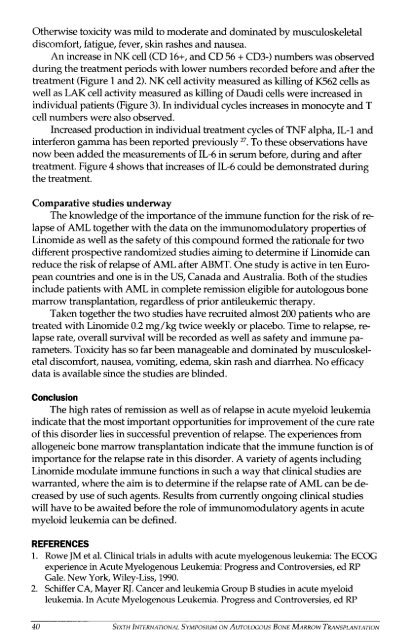VI Autologous Bone Marrow Transplantation.pdf - Blog Science ...
VI Autologous Bone Marrow Transplantation.pdf - Blog Science ...
VI Autologous Bone Marrow Transplantation.pdf - Blog Science ...
Create successful ePaper yourself
Turn your PDF publications into a flip-book with our unique Google optimized e-Paper software.
Otherwise toxicity was mild to moderate and dominated by musculoskeletal<br />
discomfort, fatigue, fever, skin rashes and nausea.<br />
An increase in NK cell (CD 16+, and CD 56 + CD3-) numbers was observed<br />
during the treatment periods with lower numbers recorded before and after the<br />
treatment (Figure 1 and 2). NK cell activity measured as killing of K562 cells as<br />
well as LAK cell activity measured as killing of Daudi cells were increased in<br />
individual patients (Figure 3). In individual cycles increases in monocyte and T<br />
cell numbers were also observed.<br />
Increased production in individual treatment cycles of TNF alpha, IL-1 and<br />
interferon gamma has been reported previously 27<br />
. To these observations have<br />
now been added the measurements of IL-6 in serum before, during and after<br />
treatment. Figure 4 shows that increases of IL-6 could be demonstrated during<br />
the treatment.<br />
Comparative studies underway<br />
The knowledge of the importance of the immune function for the risk of relapse<br />
of AML together with the data on the immunomodulatory properties of<br />
Linomide as well as the safety of this compound formed the rationale for two<br />
different prospective randomized studies aiming to determine if Linomide can<br />
reduce the risk of relapse of AML after ABMT. One study is active in ten European<br />
countries and one is in the US, Canada and Australia. Both of the studies<br />
include patients with AML in complete remission eligible for autologous bone<br />
marrow transplantation, regardless of prior antileukemic therapy.<br />
Taken together the two studies have recruited almost 200 patients who are<br />
treated with Linomide 0.2 mg/kg twice weekly or placebo. Time to relapse, relapse<br />
rate, overall survival will be recorded as well as safety and immune parameters.<br />
Toxicity has so far been manageable and dominated by musculoskeletal<br />
discomfort, nausea, vomiting, edema, skin rash and diarrhea. No efficacy<br />
data is available since the studies are blinded.<br />
Conclusion<br />
The high rates of remission as well as of relapse in acute myeloid leukemia<br />
indicate that the most important opportunities for improvement of the cure rate<br />
of this disorder lies in successful prevention of relapse. The experiences from<br />
allogeneic bone marrow transplantation indicate that the immune function is of<br />
importance for the relapse rate in this disorder. A variety of agents including<br />
Linomide modulate immune functions in such a way that clinical studies are<br />
warranted, where the aim is to determine if the relapse rate of AML can be decreased<br />
by use of such agents. Results from currently ongoing clinical studies<br />
will have to be awaited before the role of immunomodulatory agents in acute<br />
myeloid leukemia can be defined.<br />
REFERENCES<br />
1. Rowe JM et al. Clinical trials in adults with acute myelogenous leukemia: The ECOG<br />
experience in Acute Myelogenous Leukemia: Progress and Controversies, ed RP<br />
Gale. New York, Wiley-Liss, 1990.<br />
2. Schiffer CA, Mayer RJ. Cancer and leukemia Group B studies in acute myeloid<br />
leukemia. In Acute Myelogenous Leukemia. Progress and Controversies, ed RP<br />
40 SIXTH INTERNATIONAL SYMPOSIUM ON AUTOLOGOUS BONE MARROW TRANSPIANTATION

















